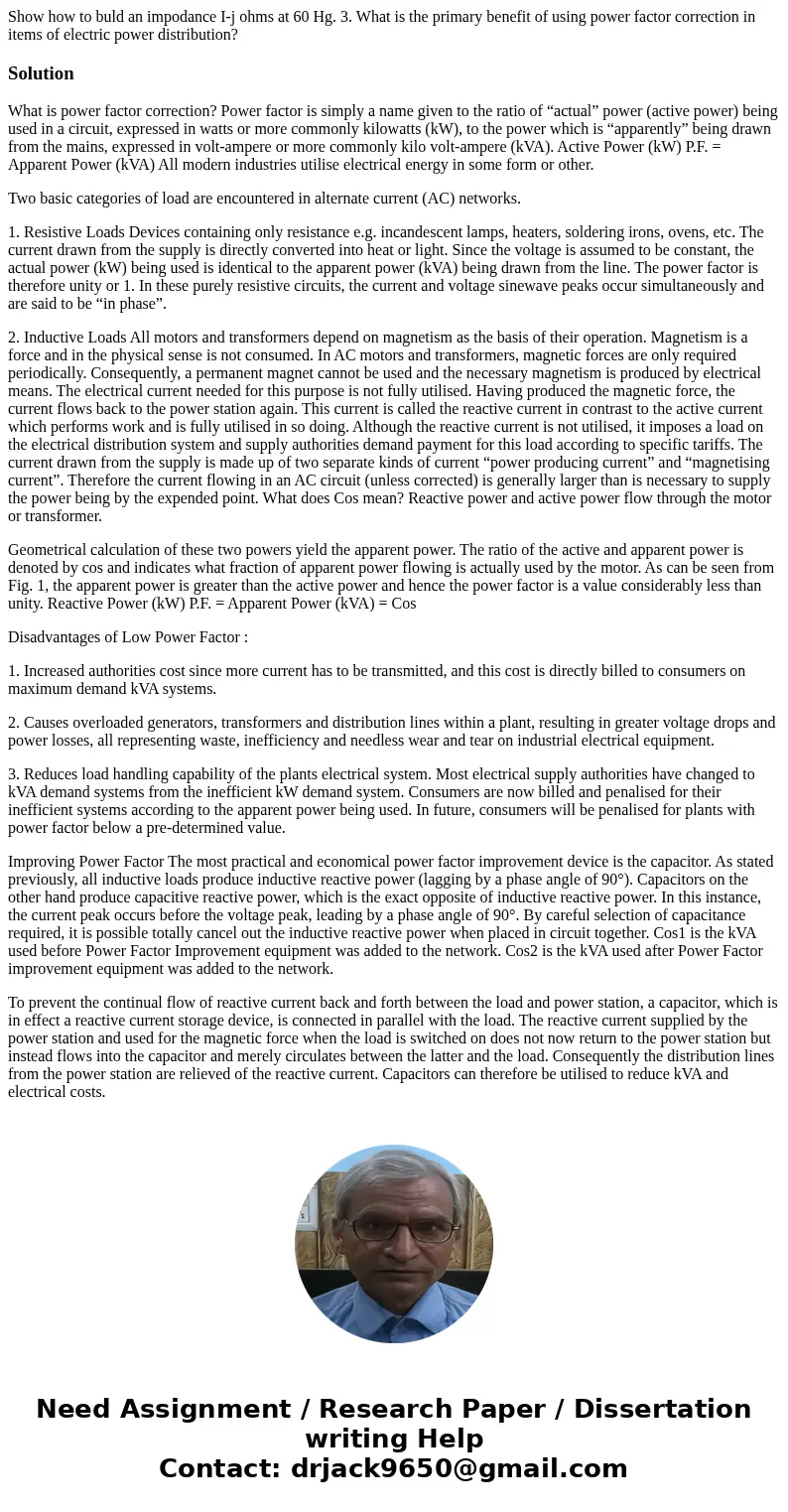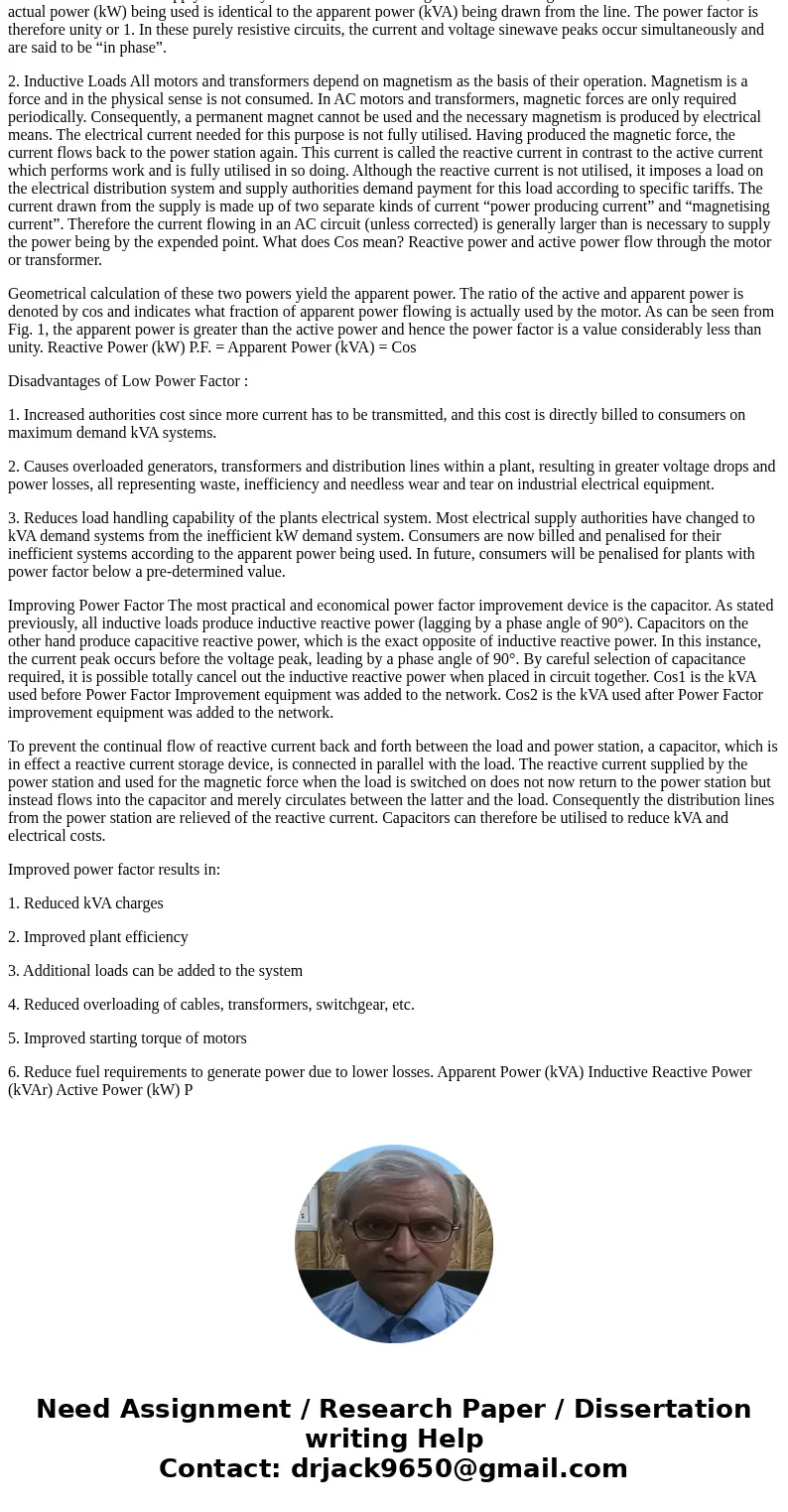Show how to buld an impodance Ij ohms at 60 Hg 3 What is the
Solution
What is power factor correction? Power factor is simply a name given to the ratio of “actual” power (active power) being used in a circuit, expressed in watts or more commonly kilowatts (kW), to the power which is “apparently” being drawn from the mains, expressed in volt-ampere or more commonly kilo volt-ampere (kVA). Active Power (kW) P.F. = Apparent Power (kVA) All modern industries utilise electrical energy in some form or other.
Two basic categories of load are encountered in alternate current (AC) networks.
1. Resistive Loads Devices containing only resistance e.g. incandescent lamps, heaters, soldering irons, ovens, etc. The current drawn from the supply is directly converted into heat or light. Since the voltage is assumed to be constant, the actual power (kW) being used is identical to the apparent power (kVA) being drawn from the line. The power factor is therefore unity or 1. In these purely resistive circuits, the current and voltage sinewave peaks occur simultaneously and are said to be “in phase”.
2. Inductive Loads All motors and transformers depend on magnetism as the basis of their operation. Magnetism is a force and in the physical sense is not consumed. In AC motors and transformers, magnetic forces are only required periodically. Consequently, a permanent magnet cannot be used and the necessary magnetism is produced by electrical means. The electrical current needed for this purpose is not fully utilised. Having produced the magnetic force, the current flows back to the power station again. This current is called the reactive current in contrast to the active current which performs work and is fully utilised in so doing. Although the reactive current is not utilised, it imposes a load on the electrical distribution system and supply authorities demand payment for this load according to specific tariffs. The current drawn from the supply is made up of two separate kinds of current “power producing current” and “magnetising current”. Therefore the current flowing in an AC circuit (unless corrected) is generally larger than is necessary to supply the power being by the expended point. What does Cos mean? Reactive power and active power flow through the motor or transformer.
Geometrical calculation of these two powers yield the apparent power. The ratio of the active and apparent power is denoted by cos and indicates what fraction of apparent power flowing is actually used by the motor. As can be seen from Fig. 1, the apparent power is greater than the active power and hence the power factor is a value considerably less than unity. Reactive Power (kW) P.F. = Apparent Power (kVA) = Cos
Disadvantages of Low Power Factor :
1. Increased authorities cost since more current has to be transmitted, and this cost is directly billed to consumers on maximum demand kVA systems.
2. Causes overloaded generators, transformers and distribution lines within a plant, resulting in greater voltage drops and power losses, all representing waste, inefficiency and needless wear and tear on industrial electrical equipment.
3. Reduces load handling capability of the plants electrical system. Most electrical supply authorities have changed to kVA demand systems from the inefficient kW demand system. Consumers are now billed and penalised for their inefficient systems according to the apparent power being used. In future, consumers will be penalised for plants with power factor below a pre-determined value.
Improving Power Factor The most practical and economical power factor improvement device is the capacitor. As stated previously, all inductive loads produce inductive reactive power (lagging by a phase angle of 90°). Capacitors on the other hand produce capacitive reactive power, which is the exact opposite of inductive reactive power. In this instance, the current peak occurs before the voltage peak, leading by a phase angle of 90°. By careful selection of capacitance required, it is possible totally cancel out the inductive reactive power when placed in circuit together. Cos1 is the kVA used before Power Factor Improvement equipment was added to the network. Cos2 is the kVA used after Power Factor improvement equipment was added to the network.
To prevent the continual flow of reactive current back and forth between the load and power station, a capacitor, which is in effect a reactive current storage device, is connected in parallel with the load. The reactive current supplied by the power station and used for the magnetic force when the load is switched on does not now return to the power station but instead flows into the capacitor and merely circulates between the latter and the load. Consequently the distribution lines from the power station are relieved of the reactive current. Capacitors can therefore be utilised to reduce kVA and electrical costs.
Improved power factor results in:
1. Reduced kVA charges
2. Improved plant efficiency
3. Additional loads can be added to the system
4. Reduced overloading of cables, transformers, switchgear, etc.
5. Improved starting torque of motors
6. Reduce fuel requirements to generate power due to lower losses. Apparent Power (kVA) Inductive Reactive Power (kVAr) Active Power (kW) P


 Homework Sourse
Homework Sourse